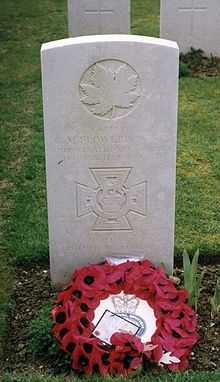Gordon Flowerdew
| Gordon Muriel Flowerdew | |
|---|---|
 | |
| Born |
2 January 1885 Billingford, Norfolk |
| Died |
31 March 1918 (aged 33) Moreuil, France |
| Buried at | Namps-au-Val Cemetery, France |
| Allegiance |
|
| Service/branch | Canadian Expeditionary Force |
| Years of service | 1914 - 1918 |
| Rank | Lieutenant |
| Unit | Lord Strathcona's Horse |
| Commands held | C Squadron, Lord Strathcona's Horse |
| Battles/wars | First World War † |
| Awards | Victoria Cross |
Gordon Muriel Flowerdew VC (2 January 1885 – 31 March 1918) was a Canadian recipient of the Victoria Cross, the highest and most prestigious award for gallantry in the face of the enemy that can be awarded to British and Commonwealth forces, received for his actions at the Battle of Moreuil Wood.
Early life
He was born in Billingford, Norfolk, England and educated at Framlingham College in Suffolk. He emigrated to British Columbia, where he took up ranching. He was homesteaded briefly in Queens Bay.
Military career
When the war broke out in September 1914, he enlisted as a private in Lord Strathcona's Horse. He rose quickly through the ranks and was commissioned as an officer in 1916. In January 1918 Flowerdew was given command of C Squadron of Lord Strathcona's Horse.
For most of the war, the Canadian Cavalry Brigade was not involved in much direct fighting, because of the static nature of the warfare. However, when the Germans launched Operation Michael and began a rapid advance in the spring of 1918, cavalry again became an important factor. In late March, as the Germans approached Moreuil and threatened to cross the L'Avre River, the last natural barrier before Amiens, the Canadian Cavalry Corps was assigned the task of stopping them. As the Germans began to enter Moreuil Wood from the east, Lieutenant Flowerdew's squadron rode around the wood and approached the Germans' flank from the north. Flowerdew ordered a cavalry charge.[1]
Riding into the fire of five infantry companies and an artillery battery, the squadron suffered atrocious casualties (more than half of the men in C Squadron were killed), and Flowerdew himself was fatally wounded. However, the cavalry charge so unnerved the Germans that they were never able to capture Moreuil Wood, and their advance turned into a retreat in early April. His actions in "The Last Great Cavalry Charge" led to the award of the Victoria Cross.
Citation

For most conspicuous bravery and dash when in command of a squadron detailed for special services of a very important nature. On reaching his first objective, Lieutenant Flowerdew saw two lines of enemy, each about sixty strong, with machine guns in the centre and flanks; one line being about two hundred yards behind the other. Realizing the critical nature of the operation and how much depended on it, Lieut. Flowerdew ordered a troop under Lieut. Harvey, VC, to dismount and carry out a special movement, while he led the remaining three troops to the charge. The squadron (less one troop) passed over both lines, killing many of the enemy with the sword; and wheeling about galloping on them again. Although the squadron had then lost about 70 per cent of its members, killed and wounded from rifle and machine gun fire directed on it from the front and both flanks, the enemy broke and retired. The survivors of the squadron then established themselves in a position where they were joined, after much hand-to-hand fighting, by Lieut. Harvey's part. Lieut. Flowerdew was dangerously wounded through both thighs during the operation, but continued to cheer his men. There can be no doubt that this officer's great valour was the prime factor in the capture of the position.
Flowerdew's Victoria Cross was one of twenty awarded during the battles of the German and Allied offensives in the Amiens area in 1918.
Alfred Munnings, who was then a largely unknown war artist, created an oil painting which depcits this cavalry charge. The canvas was formerly at the Imperial War Museum in London; but it is now in the collection of the Canadian War Museum in Ottawa.[2]

He is buried at Namps-au-Val Cemetery in France located 11 miles south-east of Amiens (plot I, row H. grave 1).
Legacy
His posthumously awarded Victoria Cross was donated by his mother to Framlingham College in England. It had been on loan to, and displayed by, the Strathcona Museum[3] from 1990 to 2002. The medal was returned to the college in 2002.
Lt. Flowerdew is a character in the award-winning and internationally-produced play, Mary's Wedding, by Canadian playwright Stephen Massicotte. The climax of the play takes place during the charge at Moreuil Wood.[4]
See also
References
- Monuments to Courage (David Harvey, 1999)
- The Register of the Victoria Cross (This England, 1997)
- VCs of the First World War - Spring Offensive 1918 (Gerald Gliddon, 1997)
External links
- Gordon Flowerdew, a featured article on Duty & Valour
- Biography at the Dictionary of Canadian Biography Online
- Gordon Muriel Flowerdew (service/personal details, photographs, citation, relevant documents, burial information)
- Find a Grave Profile of Gordon Flowerdew
- Royal Alberta Museum: "Strathcona's Horse: A Western Heritage" (2000)
- Canadian Great War Project